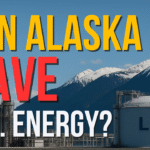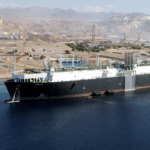Energy News Beat
Daily Standup Top Stories
How big is the Alaska LNG Project? Glenfarne says more than 50 firms interested in Alaska LNG project
The Alaska LNG Project: A Mega-Project for Energy Security and Economic Growth The Alaska LNG Project is a proposed liquefied natural gas (LNG) export initiative aimed at tapping into the vast natural gas reserves of […]
The Great Decline of California’s Energy Sector – Can the United States be “Energy Dominant” with California dragging the U.S. down?
California, once a powerhouse of diverse and reliable energy production, is facing what many analysts call a self-inflicted energy crisis. Under Governor Gavin Newsom’s leadership since 2019, the state’s energy policies have accelerated the decline […]
The $60 Oil Conundrum: Are Banks the Oracles of Oil Prices?
The oil and gas industry is no stranger to volatility, and 2025 is shaping up to be another wild ride. A recent headline grabbed the attention of investors and analysts alike: Banks Cut 2025 Oil […]
Cargo Ship Fire Sparks Concerns Over EV Safety and Insurance Challenges
In a dramatic turn of events, the Morning Midas, a cargo ship carrying approximately 3,000 vehicles—including 800 electric vehicles (EVs)—was abandoned in the Pacific Ocean on June 3, 2025, after a fire broke out 300 […]
Highlights of the Podcast
00:00 – Intro
01:03 – How big is the Alaska LNG Project? Glenfarne says more than 50 firms interested in Alaska LNG project
03:45 – The Great Decline of California’s Energy Sector – Can the United States be “Energy Dominant” with California dragging the U.S. down?
07:24 – The $60 Oil Conundrum: Are Banks the Oracles of Oil Prices?
10:24 – Cargo Ship Fire Sparks Concerns Over EV Safety and Insurance Challenges
12:47 – Outro
Follow Michael On LinkedIn and Twitter
– Get in Contact With The Show –
Video Transcription edited for grammar. We disavow any errors unless they make us look better or smarter.
Stuart Turley: [00:00:00] How big is the Alaska LNG project, and what does that mega project mean for energy security? That next, on the Energy Newsbeat Daily Standup. [00:00:08][8.3]
Stuart Turley: [00:00:16] Hello everybody, welcome to the Energy Newsbeat Daily Standup, my name’s Stu Turley, presence here at the Sandstone Group. This is… June 5th. I’ll buckle up. Here we go. How big is the Alaska LNG project? Glenn Farn says there’s more than 50 firms interested in the Alaska lng project. The great decline of California’s energy sector. How can the United States be energy dominant with California dragging the US down. $60 oil conundrum. Are the banks the oracles of oil prices? Or is it the bull in my backyard? Cargo ship fire sparks concerns over EV safety and insurance challenges. Holy smokes, Batman. Let’s get ready to rumble. [00:01:03][46.6]
Stuart Turley: [00:01:03] How big is the Alaska LNG project? Glenn Farn says there’s more than 50 firms interested in the Alaska. Ellen G project. This is huge. I love Alaska. And if you’ve listened to the podcast, you know that my grandfather was one of the founding. Geologist on the North slope. I’ve loved all my trips to Alaska. Love all the fun folks up in Alaska and it is a great thing. Hats off to Secretary Burgum and Secretary Wright. This is a Great story. The Alaska LNG project is an integrated natural gas infrastructure endeavor comprising three main components. Gas treatment plant located in Prudhoe Bay. This facility will process natural gas from the north slope fields removing impurities preparing it for transport designed to handle approximately excuse me three billion cubic feet bcf of gas per day with carbon dioxide captured and injected to reduce emissions that’s huge number two at 807 mile pipeline, a 42 inch Diana pipeline will transport gas from the North slope. To an LNG liquefaction facility in Niski on Alaska’s Kenai Peninsula. The pipeline on a daily capacity of 3.3 BCF includes multiple compressor stations and interconnection points for in-state guest distribution. Huge. And then a LNG export terminal. The Niske facility will liquefy up to 20 million metric tons. MTPA of LNG equivalent to 25 BCF of gas per 2.5 BCF gas per day. That is absolutely huge. And there’s customers already lining up on this bed. And I think it’s absolutely wonderful in this article on energy newsbeat.co. We have secretary Wright doing an interview while he’s there in Alaska on the North slope been there. It’s a kind of cool place. And when you sit back and take a look at the recent development firms, there are some big economic and tough jobs ahead. When I was lucky enough to meet with the Aliesca pipeline folks, when that was going on, there is a lot of environmental concerns, there’s going to be environmental lawfare over this and it’s absolutely horrific that they’re going to see all that, but you know what Alaskans love oil and gas. And we love them as well too. [00:03:45][161.1]
Stuart Turley: [00:03:45] So let’s get rolling over here to the next story. The great decline of California’s energy sector. Speaking of energy importance or dominance, the great decline of California is energy sector can the United States be energy dominant with California dragging the U S down. This is a critical story. And when you sit back and take a look, Nathan hammer provided some very good research material. And prompted me to write this story. I had just interviewed a Ronald Stein as well as Mike Umbro. I believe it was last week and I included the link in the article. It was an excellent podcast. And then Ronald Stein reached out and said, Newsome remains oblivious to the fact that we are a materialistic society dependent on more than 6,000 products made from fossil fuels. Newsom continues to believe that the elimination of gasoline is just one of the 6,000 products with his upcoming ban on new ICE vehicles in the upcoming year will clean up California, unable to stop society’s demand from the other 5,999 products. His war on fossil fuel has set up California for the fourth largest economy in the world as a national security risk for America. This is extremely huge and there are three graphics on this article that you have got to just take a look and see 1980 the oil and then you take a look at 2024 you take look at this big old graph and it’s going wow he has decimated the oil production California used to be an energy independent state then you look at the natural gas that took a little bit of a dive then they back a little bit and now right on back down. Nuclear, they barely kept the Diablo Canyon open and I’m glad that they did. But when we take a look at this, there’s a chart in here. Provided by Sandstone Capital Asset Group and that is you take a look at the average cost of California electricity. It is twice what the United States average is or near twice and it is disgusting what his energy policies have done by blaming it. But then Nathan Hammer’s graph in here is absolutely the most important one when you take a look at it. Maybe not the most important but pretty darn important. There’s a lot of red on this foreign import for the supply mix for California. California is an energy import black hole of energy and it is absolutely disgusting. Hats off to Nathan Hammer, Mike Umbro, as well as Ronald Stein for helping get the information that I needed for this story. This is a huge story and I would like to reach out to the Trump administration and quite honestly ask them and say, what are you going to do when the fourth largest economy in the world is on this kind of a crash course with a fiscal calamity and it is not going to allow the United States to be energy dominant when you have a energy dunce running California. You have the biggest state sitting there being a black hole of energy. And it’s not good way to go. Governor Newsom, I hope you have a great day. [00:07:23][218.2]
Stuart Turley: [00:07:24] Let’s go to the next story here. The $60 oil conundrum are banks oracles of oil prices. Tickled at writing this story is because this story came from Haynes and Boone, a survey of 28 banks. I’ve always enjoyed my interviews and discussions with the folks at Haynes and Boon law firm. They are a good group of people. And so I got tickled when I read the. The output and it is the that they’re saying that an average of 5830 for the 2025 is a 5.8% drop from their December projections. So I started digging around and kind of looking around and go, why are the bankers betting at $60? Well Goldman Sachs And the bottom line of this thing is do your homework. Take a look at your investments. Take a Look at your portfolio, watch Jim Kramer and do the exact opposite of what Jim Kramer does. But let’s take a look here. And that’s called the Kramer effect. Goldman Sachs, for instance, now sees Brent averaging $60 for in 2025 down from 63 and WTI down. At 56 up down from 59 JP Morgan is even more bearish forecasting Brent at 66 and WTI at 62 for 2025. So I’m going to just sit back and kind of smile and go my bully in my backyard, I think has got more data and more information than they do because my bully is thinking it’s still going to be a little higher. And I don’t think that you can sit back and say commodities and high traders or OPEC and the international EIA, who’s got a better grip on it. But I can tell you right now, there are concerns coming out about Russia being able to produce any more because of physical liabilities, nothing else. They’re just maybe tapped out at the moment. You take a look at all of the other OPEX plus spikes that are out there. And this is most, and I don’t have any information on this, but it’s Almost. Is Saudi Arabia turning loose the hounds to try to increase their production? Try to get them back to pull them back in and say hey guys you can’t produce anymore let’s stick with our quotas i don’t know it seems like a mind game that they don’t have a control on but my opinion is if you if we had four trillion dollars we would be able to meet decline curves around the world as they are now guess what’s not being invested in oil and gas And that usually means that when you don’t, your short investment, that means prices go up higher if demand remains high, we are seeing demand remaining high, the biggest problems for oil is Iran, Russia, Iraq, Israel, and geopolitical situations going on at some big issues. [00:10:23][179.2]
Stuart Turley: [00:10:24] Let’s go to this last story here. And I’d like to give a Reese consulting a shout out Reese energy Go to reeseenergyconsulting.com. They are fabulous folks over there. If you are moving molecules from the Haynesville or the Permian, and you want to get it over to Germany, they are the ones to be able to call and say. Give me some molecule transfer right now, stat, and they can get it done for you. They can also say, wait a minute, I got a data center. Where do I put it in the United States? And they can even figure out contracts and get you guaranteed LNG or not LNG, a natural gas pipeline and say, Hey, wait, a minute. Let’s get this thing done. If you have a data Center call Reese energy consulting.com. [00:11:09][45.1]
[00:11:11] Last story kind of intrigued me a little bit. I saw this cargo ship fire sparks concerns over EV safety and insurance challenges. If anybody understands that insurance companies rule the world, this one is really got me kind of triggered up here. You sit back and kind of go the morning Midas is a stark reminder of the challenges posed by a global shift to EVs while EVs offer environmental benefits their lithium ion batteries introduced risk that the maritime and insurance industries are still learning to manage. For car carriers, stricter safety protocols and rising insurance costs could reshape the economics of vehicle transport. I’m wondering if we ought to take a look at putting batteries separated from the cars when you import an EV from China. Could be a completely interesting mix as opposed to roll on, roll off transport carriers. I don’t know how that’s going to work. But Jerry Naughton, a risk consultant over at Chubb, emphasized that homeowners are not currently required to notify insurance when purchasing an EV and EV ownership does not automatically increase premiums. However, I’ve spoken to homeowners that had their car insurance and their homeowners and their homeowner has gone up. So if you own an EV, get ready to pay a lot more for insurance. So if you own a one roll off vehicle carrier or transport, get ready for some higher insurance. [00:12:45][94.6]
Stuart Turley: [00:12:47] So with that, like, subscribe, share, go to energy newsbeat.co. If you’ve got any questions or go to the energy news beat.substack.com. If you’re a paid subscriber, we answer those chat, the new paid feature chat, if you on there and you say, Hey, I want to know about this. We’ll do the research and get an article written on it. And we’d love to visit with you. Thank you and have an absolutely fantastic day. [00:12:47][0.0][753.1]
The post How Big is the Alaska LNG – What does that mean for Energy Security appeared first on Energy News Beat.









